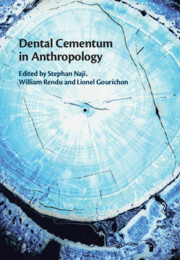Book contents
- Dental Cementum in Anthropology
- Dental Cementum in Anthropology
- Copyright page
- Dedication
- Contents
- Contributors
- Foreword
- Introduction: Cementochronology in Chronobiology
- Part I The Biology of Cementum
- Part II Protocols
- 9 Cementochronology for Archaeologists: Experiments and Testing for an Optimized Thin-Section Preparation Protocol
- 10 Optimizing Preparation Protocols and Microscopy for Cementochronology
- 11 Cementochronology Protocol for Selecting a Region of Interest in Zooarchaeology
- 12 Tooth Cementum Annulations Method for Determining Age at Death Using Modern Deciduous Human Teeth: Challenges and Lessons Learned
- 13 The Analysis of Tooth Cementum for the Histological Determination of Age and Season at Death on Teeth of US Active Duty Military Members
- 14 Preliminary Protocol to Identify Parturitions Lines in Acellular Cementum
- 15 Toward the Nondestructive Imaging of Cementum Annulations Using Synchrotron X-Ray Microtomography
- 16 Noninvasive 3D Methods for the Study of Dental Cementum
- Part III Applications
- Index
- Plate Section (PDF Only)
- References
12 - Tooth Cementum Annulations Method for Determining Age at Death Using Modern Deciduous Human Teeth: Challenges and Lessons Learned
from Part II - Protocols
Published online by Cambridge University Press: 20 January 2022
- Dental Cementum in Anthropology
- Dental Cementum in Anthropology
- Copyright page
- Dedication
- Contents
- Contributors
- Foreword
- Introduction: Cementochronology in Chronobiology
- Part I The Biology of Cementum
- Part II Protocols
- 9 Cementochronology for Archaeologists: Experiments and Testing for an Optimized Thin-Section Preparation Protocol
- 10 Optimizing Preparation Protocols and Microscopy for Cementochronology
- 11 Cementochronology Protocol for Selecting a Region of Interest in Zooarchaeology
- 12 Tooth Cementum Annulations Method for Determining Age at Death Using Modern Deciduous Human Teeth: Challenges and Lessons Learned
- 13 The Analysis of Tooth Cementum for the Histological Determination of Age and Season at Death on Teeth of US Active Duty Military Members
- 14 Preliminary Protocol to Identify Parturitions Lines in Acellular Cementum
- 15 Toward the Nondestructive Imaging of Cementum Annulations Using Synchrotron X-Ray Microtomography
- 16 Noninvasive 3D Methods for the Study of Dental Cementum
- Part III Applications
- Index
- Plate Section (PDF Only)
- References
Summary
In recent years, the Tooth Cementum Annulations method has been demonstrated to be highly effective at estimating age at death in permanent teeth. Prior to this study, no validation studies have attempted to use TCA to age deciduous teeth. Deciduous teeth provide unique challenges for anthropologists seeking to use the TCA method. Among these are the constraint that cementum annulations are only countable immediately before and after the root apex closes, and the fact that in healthy teeth the cementum record is destined to be destroyed by rhizolysis, so cementum annulations will only be available in teeth that are surgically extracted, or in teeth from juvenile decedents. From a practical standpoint, we found that methods that had previously yielded good results in permanent teeth worked much less well in deciduous teeth. The use of high magnification, bright-field illumination, and analyzing multiple regions of interest per tooth are all recommended for best results.
Keywords
- Type
- Chapter
- Information
- Dental Cementum in Anthropology , pp. 215 - 225Publisher: Cambridge University PressPrint publication year: 2022

